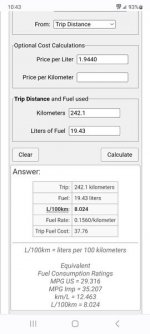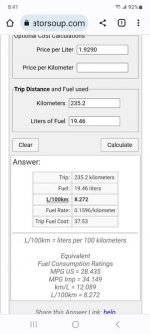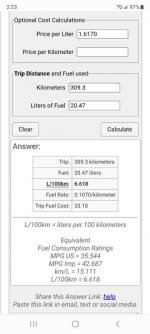-
There were many reasons for the change of the site software, the biggest was security. The age of the old software also meant no server updates for certain programs. There are many benefits to the new software, one of the biggest is the mobile functionality. Ill fix up some stuff in the coming days, we'll also try to get some of the old addons back or the data imported back into the site like the garage. To create a thread or to reply with a post is basically the same as it was in the prior software. The default style of the site is light colored, but i temporarily added a darker colored style, to change you can find a link at the bottom of the site.
You are using an out of date browser. It may not display this or other websites correctly.
You should upgrade or use an alternative browser.
You should upgrade or use an alternative browser.
Was this a Fuel Indicator Reserve Notification?
- Thread starter ff73148
- Start date
K80Shooter
Active member
On a long ride my fuel gauge showed a range of 33 miles. Soon it showed no miles but three little lines. ---
What does that mean? Was I on reserve? There is no explanation in the owners manual.
It only reads to a certain point, 25 maybe? then the three dots appear. In reality it means get fuel soon.
It only reads to a certain point, 25 maybe? then the three dots appear. In reality it means get fuel soon.
Well K80, NO, that word 'soon' in there is not really appropriate!
These Spyders, just like most modern motorcycles and effectively any other vehicle with Electronic Fuel Injected engines, don't really have a 'Fuel Reserve' like older style motorcycles where the tank divided at the bottom to form around the main spar, leaving a 'well' of gas separated from the usual petcock outlet, so it didn't run (by gravity) into the engine until you selected 'Reserve' on that petcock. Modern motorcycles usually don't have ANY 'Reserve' per se, and EFI engines generally feed the injectors gas supplied by a High-Pressure Fuel Pump immersed in the tank. Those pumps run at extremely fine tolerances and develop a lot of heat doing so, with the heat dispersed into whatever gas is left in the tank as the pump is meant to be fully immersed in it; and at the same time the liquid gas is also acting as a lubricant for the rotating components of the pump that are running extremely closely together, again, it can do this cos the pump is meant to be fully immersed in gas. Once the Low Fuel Warning Light comes on, you are really pushing the limits of the remaining gas being able to properly disperse that heat &/or still have enough gas left to act in the designed/intended way as a lubricant; AND you are also risking sucking up any of the smaller molecules of heavier non-inflammable liquids like water, condensation, & any other crud that DOES get into the gas thru normal use over time and which generally remains suspended in the liquid, albeit because of its heavier & usually slightly larger molecules, usually ends up gathered in the liquid in the lowest parts of the tank - but none of that is a good thing!:banghead:
So if you EVER get to the 'Three Dots' display stage, you are risking destroying your injector pump &/or damaging the injectors, either thru over-heating things as the smaller quantity of gas remaining can no longer absorb any excess heat developed by the pump as it operates; or by sucking up the 'slightly larger than gas' molecules of water, condensation, &/or other liquid suspended crud that's always floating in the gas down there! Basically, you SHOULD NEVER RUN YOUR TANK DRY and those Three Dots mean that you're bloody close to doing that! If you want to keep your injector pump and system healthy for as long as you can, you should ALWAYS start looking for gas BEFORE the Low Fuel Warning Light comes on, which usually means treating about 1/4 of a tank remaining as your 'Refill Soon' marker, the Warning Light as your Last Warning, and those Three Dots as your 'DAMMIT, I hafta add more gas RIGHT NOW, cos I'm probably already damaging things' level! :lecturef_smilie:
And all of this is why many people who regularly travel long distances (on Spyders as well as EFI engined motorcycles & cars!
Just Sayin' - Again!
Last edited:
ARtraveler
R.I.P. Dwayne
Now that the guage question is answered:
I also agree. Fill the tank sooner, rather than later. The range is supposed to be over 200 miles now. I usually refill my tank even before the low fuel light comes on. That means I think about gas somewhere between 150 and 200 miles on the odometer. Most people want to get off after 150 miles anyway.
I also agree. Fill the tank sooner, rather than later. The range is supposed to be over 200 miles now. I usually refill my tank even before the low fuel light comes on. That means I think about gas somewhere between 150 and 200 miles on the odometer. Most people want to get off after 150 miles anyway.
Last edited:
GFrog
Member
Most of the time I refuel when the 3 dash lines appear. I usually top-up the tank every time I refuel. It usually takes between 19.5 to 20.5 liters of fuel to fill the tank.
The tank capacity is 26.5 liters (7 US gal).
This means that I normally have about 6 to 7 liters (1.6 to 1.8 US gal) of fuel left in the tank when the 3 dashes and low fuel light appear.
So now I know how much fuel I have left when the low fuel light appear.
In order to keep the fuel pump cool, I would not want to go too far below the Low Fuel light.
![Screenshot_20230917_203556_Chrome[1].jpg Screenshot_20230917_203556_Chrome[1].jpg](https://www.spyderlovers.com/data/attachments/114/114936-ef8190306828f619c71b50bba07cc0ea.jpg?hash=db9s-9TekW)
![Screenshot_20230901_174305_Chrome[1].jpg Screenshot_20230901_174305_Chrome[1].jpg](https://www.spyderlovers.com/data/attachments/114/114937-327d61f7a311888e336509923960e191.jpg?hash=DkJuMAIaLk)



The tank capacity is 26.5 liters (7 US gal).
This means that I normally have about 6 to 7 liters (1.6 to 1.8 US gal) of fuel left in the tank when the 3 dashes and low fuel light appear.
So now I know how much fuel I have left when the low fuel light appear.
In order to keep the fuel pump cool, I would not want to go too far below the Low Fuel light.
![Screenshot_20230917_203556_Chrome[1].jpg Screenshot_20230917_203556_Chrome[1].jpg](https://www.spyderlovers.com/data/attachments/114/114936-ef8190306828f619c71b50bba07cc0ea.jpg?hash=db9s-9TekW)
![Screenshot_20230901_174305_Chrome[1].jpg Screenshot_20230901_174305_Chrome[1].jpg](https://www.spyderlovers.com/data/attachments/114/114937-327d61f7a311888e336509923960e191.jpg?hash=DkJuMAIaLk)



As has been said, --- means you need to refuel very soon. Depends where you are traveling when to begin to refuel. Out West where distances are further apart between stations off the beaten path. or in locations of remote Canada and Alaska where when you are down to half a tank you start looking for fuel or carry a spare container. Out East where gas is plentiful one can run down to the low fuel light.
ff73148
Member
Thanks for the replies. Just to give a little more information. When I fueled up the bike took 5.5 gallons. So I assume that there was 1.5 gallons left. What drives me crazy is there is no mention in the owners manual explaining this issue. Every other company does. BTW I asked BRP about this and their response was to go to the dealer. Frustrating.
Knowing about the fuel pump issue, I make it a habit to fill up once I drop below half full. Typically that means I have ridden about 150 miles or so. I think the longest I have ridden on my Spyder before filling up was about 180 miles. Everytime I fill up I try to really fill the tank if the pump I am using allows me to reduce the flow to where I can get the tank as full as possible without splashing gas all over the place. I think that 4.5 gallons was the most that I have ever put into the tank at one time. I use the same thinking for all three of my cars, i.e., looking to fill up whenever I drop below half full, but I don't "top off" the cars as I don't see a need to do so. I never really thought about carrying "emergency" gas with me, but maybe having a half gallon or so stored in my frunk is not a bad idea.
ARtraveler
R.I.P. Dwayne
RE: emergency gas. I would NOT recommend carrying emergency gas except when you are in areas where you might be too far in between gas stations. I lived in Alaska for 20 years and only carried emergency gas once.
The container is very important. There are very few "crash worthy" gas containers. REDA brand is one of them. The "standard" plastic gas cans are bombs waiting to explode. :bowdown:
The container is very important. There are very few "crash worthy" gas containers. REDA brand is one of them. The "standard" plastic gas cans are bombs waiting to explode. :bowdown:
BLUEKNIGHT911
Sadly Passed Oct 2024 - RIP
^^^ as long as you rotate out that emergency gas monthly.
IMHO you only need to do it monthly ....IF you don't use a little " Fuel stabilizer " like Stabil etc. in that container.....Mike :thumbup:
BLUEKNIGHT911
Sadly Passed Oct 2024 - RIP
RE: emergency gas. I would NOT recommend carrying emergency gas except when you are in areas where you might be too far in between gas stations. I lived in Alaska for 20 years and only carried emergency gas once.
The container is very important. There are very few "crash worthy" gas containers. REDA brand is one of them. The "standard" plastic gas cans are bombs waiting to explode. :bowdown:
IMHO opinion I dis-agree .... WHY ???? .... how safe is the OEM Gas tank compared to a sturdy plastic container ?????? .... The plastic container CANNOT cause a Spark, that can't be said of the OEM gas tank .... Also if you are in a crash that is so severe it could cause either one to Ignite ..... I think that might be the least of your worries ...... Mike :thumbup:
eddieshep999
Active member
This is one of those questions that has provided excellent answers and it’s why this forum is great at keeping all informed
Thanks to all those that responded to the question
I’ve learnt something new and have only had the 3 Dots appear once but I was only 2 miles from a Petrol station and 1 mile of that was downhill so I able to run my Spyder hardly using the throttle
I now normally fill up when the range shows 50 left or as soon as the Low Fuel light and Warning is displayed
Thanks for the useful information
Thanks to all those that responded to the question
I’ve learnt something new and have only had the 3 Dots appear once but I was only 2 miles from a Petrol station and 1 mile of that was downhill so I able to run my Spyder hardly using the throttle
I now normally fill up when the range shows 50 left or as soon as the Low Fuel light and Warning is displayed
Thanks for the useful information
Gwolf
Well-known member
RE: emergency gas. I would NOT recommend carrying emergency gas except when you are in areas where you might be too far in between gas stations. I lived in Alaska for 20 years and only carried emergency gas once.
The container is very important. There are very few "crash worthy" gas containers. REDA brand is one of them. The "standard" plastic gas cans are bombs waiting to explode. :bowdown:
The Rotopax fuel containers and the MSR Fuel Bottles are both probably more safe than the OEM fuel tank between your legs. Both are used by miliytary as well as many off road vehicles traveling in rough terrain.
In a crash bad enough to break open a Rotopax or an MSR Fuel Bottle, it is unlikely you are still going to be anywhere near the spot where the trike lands anyway.
redrazor
Member
Now that the guage question is answered:
I also agree. Fill the tank sooner, rather than later. The range is supposed to be over 200 miles now. I usually refill my tank even before the low fuel light comes on. That means I think about gas somewhere between 150 and 200 miles on the odometer. Most people want to get off after 150 miles anyway.
:agree:
RayBJ
Well-known member
The Rotopax fuel containers and the MSR Fuel Bottles are both probably more safe than the OEM fuel tank between your legs. Both are used by miliytary as well as many off road vehicles traveling in rough terrain.
In a crash bad enough to break open a Rotopax or an MSR Fuel Bottle, it is unlikely you are still going to be anywhere near the spot where the trike lands anyway.
I use a Rotopax 1.75 gal container mounted on the rear deck of my RT when traveling multi-states west of the Mississippi. I hide it with a helmet bag (see my avatar). As stated, if a crash reaches that far, odds are gas is the least of my problems!
EdMat
Well-known member
Word of caution on "topping" the fuel tank off is that raw fuel can get into the fuel evaporator system and cause engine issues not to mention messing up fuel relay system.
Which model?
Similar threads
- Replies
- 12
- Views
- 2K
- Replies
- 13
- Views
- 4K
- Replies
- 8
- Views
- 1K
- Replies
- 13
- Views
- 842
